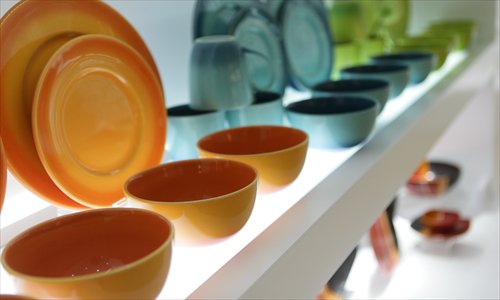What’s for dinnerware?

Foodies amateur and pro alike find that the vessel can dramatically alter a meal's aesthetic value. Photo: CFP
When Zhang Haixia, 38, an avid food blogger, placed a peach custard into her similarly peachy-orange bowl and garnished it with a green herb, she took a moment to photograph the brilliant display of color.
Zhang later posted the photo on her blog, Bright Yangyang, which features artfully composed photos of the meals she prepares for her family. She developed a keen interest in more than food, but plating, too, in 2008, when she first started up her blog. Zhang said that her mind is always thinking about new ways of combining food with different kinds of tableware.
Zhang told Metropolitan that over the years, she developed her own code for choosing appropriate dinnerware.
"White is the best color and can fit almost any dish. Simple square or round plates are a good fit for cold dishes, while bright, saturated colors are best suited to dessert," said Zhang. She dished out that her favorite plate of the moment is one with a heart-shaped depression in the middle.
Most of the time, Zhang buys her dishes on Taobao, the largest online shopping website. She spent more than 2,000 yuan ($327) last year buying new crockery on Taobao, mostly porcelain pieces costing around 20 yuan each.
Famed food critic and food advisor for the CCTV program A Bite of China, Dong Keping told Metropolitan that the focus on the tableware first started to become trendy about 10 years ago.
"Without the proper tableware, delicious food cannot become a delicacy," he said.
However, Dong noted that, "Not everyone uses tableware properly. The usage of tableware with different foods is a test of a chef's personal aesthetics."
According to Dong, the materials of fine dishes are diverse and include tile, wood and stone, but porcelain remains the most common.
Dong said that a chef must really have a vision of their creation in mind in order to properly choose the tableware.
For instance, Dong said that some people use the expensive encaustic tile - made from the same process as Old Beijing's shiny roof tiles - to plate traditional Beijing snacks.
"This looks strange and is a waste of fine tableware," said Dong. Instead, he suggested using red encaustic tiles to plate mushrooms and contrasting, jade green garnishes.
For fine dining experts like Dong, the tasteful marriage of dish and food is an important skill, but as the fine dinnerware trend catches on with a wider audience, attractive tableware is enough to entice them to buy.
Doris Chen, 30, president of Danlütang art company, told Metropolitan that her interests are in buying boldly colored dishes for her not-yet-1-year-old son. She buys place settings with cartoonish bear and owl shapes.
She uses the cute plates, mostly found on Taobao and Amazon, mainly for presenting mashed baby food.
"I think their beautiful appearance catches my son's attention so that he will eat more," said Chen, adding that most of the items, such as bowls and plates, cost around 50 yuan each.
For Chen, the safety of the products she buys, even with tableware, is essential.
Wang Wei, founder of porcelain dish retailer Gogo China, told Metropolitan that different kinds of glazings present different health risks.
Underglazed porcelain, he said, is safer than overglazed because the paint of underglazed dishes sits beneath the veneer and can't contact the food directly.
Wang added that it's hard to judge the difference between the two just by sight, but if consumers can handle the dishes, they can feel the difference because the overglazed porcelain is not as smooth.
Wang entered the porcelain tableware business 10 years ago, and said that since 2008, he has seen a distinct rise in interest in higher-end dinnerware.
"Most of our products are above 1,000 yuan. The traditional, Chinese-style porcelain is still more popular than Western porcelain," said Wang.
For food expert Dong, pleasing plating is all about "having a diverse selection" of dinnerware to suit all the creative combinations of innovative culinary concoctions.